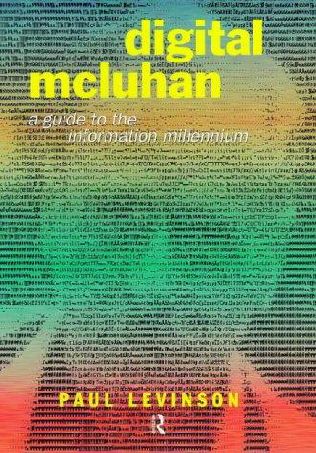Paul Levinson: Digital McLuhan: A Guide to the Information Millennium (1999)
Filed under book | Tags: · computing, global village, internet, mass media, media, media theory

“Marshall McLuhan died on the last day of 1980, on the doorstep of the personal computer revolution. Yet McLuhan’s ideas, developed in the 1950s, ’60s and ’70s, presaged a world of media in motion, and its impact on our lives on the dawn of the new millennium. McLuhan’s phrase, “the medium is the message” is his best known and most misunderstood concept. Paul Levinson presents the accuracy of McLuhan’s thinking unavailable while he was alive, and shows him as a man struggling to communicate in an electronic pattern via the straightjacket of paper. Levinson also examines why McLuhan’s theories about media are more important to us today than when they were first written, and why the Wired generation is now turning to McLuhan’s work to understand the global village in the digital age. By exploring the technological influence in industries from publishing to politics, entertainment to business, McLuhan opened the doors for understanding the human relationship with technology. Levinson’s own exploration of McLuhan’s significance in the new electronic generation clarifies the prophetic insights, principles and constructs in McLuhan’s work.”
Publisher Routledge, 1999
ISBN 041519251X, 9780415192514
226 pages
Keywords and phrases: personal computer, theremin, rear-view mirror, Marshall McLuhan, tetrad, Connected Education, Neil Postman, RealAudio, mass media, CP/M, Communications Decency Act, global village, Media Ecology, Internet, Gutenberg Galaxy, Paul Levinson, voyeurs, Eric McLuhan, Kaypro, RealVideo.
PDF (updated on 2022-11-12)
Comments (4)Media Reform: Democratizing the Media, Democratizing the State (2002)
Filed under book | Tags: · democracy, journalism, mass media

Media Reform examines a complex process: the reform of media and its role promoting democratic practices. Using examples of media from a range of countries in Latin America, Europe, Asia and Africa, Media Reform considers the social and cultural implications of a free and independent media.
Editors Monroe Edwin Price, Beata Rozumilowicz, Stefaan G. Verhulst
Publisher Routledge, 2002
ISBN 041524353X, 9780415243537
Length 283 pages
Keywords and phrases
Uzbekistan, mass media, Uruguay, Ukraine, demonopolization, JRTV, Montevideo, Ukrainian, Dziennik Ustaw, Sfor, Kampala, media in Poland, Dayton Accords, TVRI, Uzbek, Tashkent, journalists, Suharto, Al-Arab al-Yawm, Jakarta
More info (publisher)
More info (google books)
Roger Silverstone: Television And Everyday Life (1994)
Filed under book | Tags: · life, mass media, media culture, television

Television and Everyday Life explores the enigma of television, and how it has insinuated its way so profoundly and intimately into our daily lives. The book unravels television’s emotional, cognitive, spatial, temporal and political significance.
Drawing from a broad range of literature–from psychoanalysis to sociology, from geography to cultural studies–Roger Silverstone constructs a theory which places television in a central position within the various realities and discourses which construct everyday life. The medium emerges from these arguments as a fascinating, complex phenomenon of contradictions, yet the book explodes many of the myths surrounding what has been called “The Love Machine”.
Television and Everyday Life presents a radical new approach to the medium, one that both challenges closely-held wisdoms, and offers a compellingly original view of where telvision sits in everyday life.
Publisher Routledge, 1994
ISBN 0415016479, 9780415016476
Length 204 pages
Keywords and phrases
soap opera, ontological security, television, moral economy, Silverstone, mass media, suburbanisation, situation comedy, Frankfurt School, post-modern, phenomenology, commodification, Marilyn Strathern, polysemy, Radway, sit-coms, David Morley, Daniel Miller, object relations theory, privatisation
More info (publisher)
More info (google books)

